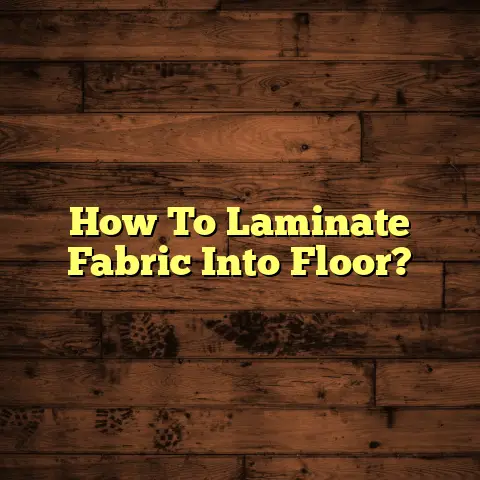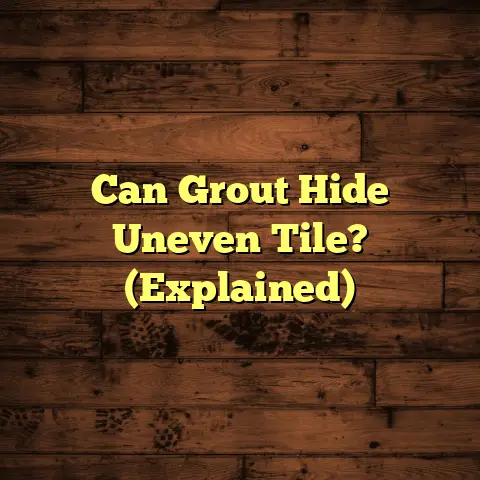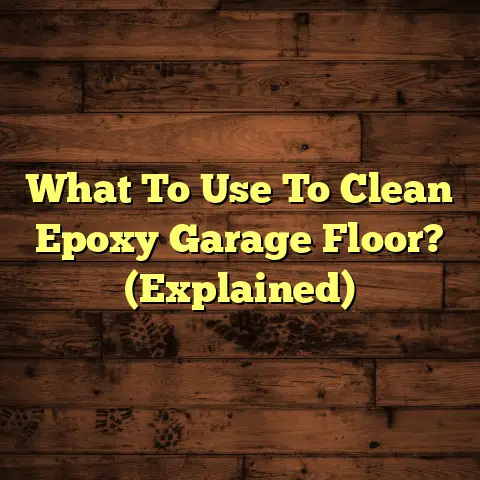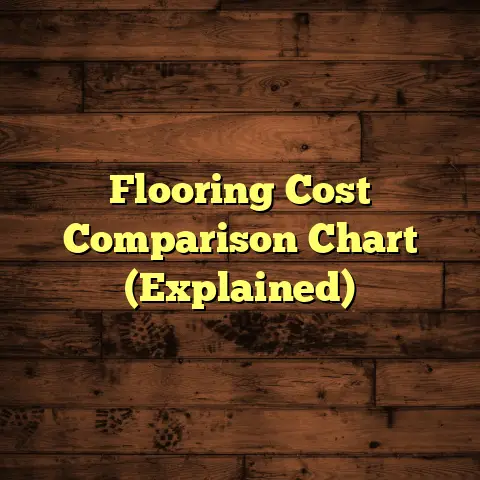What Does LVP Flooring Stand For? (1 Secret Meaning!)
What Does LVP Flooring Stand For? (1 Secret Meaning!)
(Image: A split image showing the rich, natural grain of traditional hardwood flooring on one side, contrasted with the modern, stylish appearance of LVP flooring on the other. Close-ups highlight the texture and color variations in each.)
Ever walked into a room and just loved the flooring? Flooring sets the whole vibe, doesn’t it? I’ve seen it all in my years as a flooring contractor. From classic hardwoods to trendy tiles.But lately, one type of flooring has been stealing the show: Luxury Vinyl Plank, or LVP.
Flooring choices have evolved so much. Remember the linoleum of the past? LVP is a whole new ballgame.
It’s durable, stylish, and budget-friendly. It’s no wonder it’s become so popular. Let’s dive deep into the world of LVP. What it is, why it’s so great, and even a little secret meaning behind it.
Section 1: Overview of LVP Flooring
1. Define LVP Flooring:
Okay, let’s get the basics down. LVP stands for Luxury Vinyl Plank. Pretty straightforward, right?
But what is it exactly?
It’s a type of flooring designed to mimic the look of real hardwood. But it does it with layers of synthetic materials.
Think of it like a high-tech sandwich. Each layer plays a crucial role:
- Wear Layer: This is the top layer. The one that takes all the abuse. It’s a clear, protective coating that resists scratches, stains, and wear. The thicker the wear layer, the more durable the floor. I usually recommend at least a 20 mil wear layer for high-traffic areas.
- Design Layer: This is where the magic happens. It’s a high-resolution printed image that gives the LVP its realistic wood or stone look. Thanks to advancements in printing technology, these designs can be incredibly convincing.
- Core Layer: This is the heart of the plank. It provides stability, strength, and water resistance. There are different types of cores, like WPC (wood-plastic composite) and SPC (stone-plastic composite). SPC cores are denser and more rigid, making them even more durable.
- Backing Layer: This is the bottom layer. It provides cushioning and helps to reduce noise. Some LVP comes with an attached underlayment for added comfort and sound insulation.
Now, how is this “sandwich” made? The manufacturing process involves several steps:
- Mixing: The raw materials (PVC, plasticizers, stabilizers, and pigments) are mixed together.
- Extrusion: The mixture is then extruded into sheets or planks.
- Printing: The design layer is printed onto the core layer using high-resolution printers.
- Embossing: A textured surface is embossed onto the wear layer to mimic the look and feel of real wood or stone.
- Cutting: The planks are cut to the desired size and shape.
- Coating: A protective coating is applied to the wear layer to enhance its durability.
2. Historical Context:
Vinyl flooring has been around for a while. Its origins can be traced back to the early 20th century.
The earliest versions were simple, sheet vinyl. They were primarily used in kitchens and bathrooms.
Think of those old linoleum floors. Durable, sure, but not exactly stylish.
Over time, vinyl flooring technology improved. Manufacturers started experimenting with different materials and designs. This led to the development of more sophisticated vinyl products.
LVP is the culmination of these advancements. It combines the durability and water resistance of vinyl with the aesthetic appeal of real wood or stone.
Compared to those early versions of vinyl, modern LVP offers:
- Better Durability: Advanced wear layers provide superior scratch and stain resistance.
- More Realistic Designs: High-resolution printing technology creates incredibly convincing wood and stone looks.
- Improved Comfort: Thicker planks and attached underlayments provide added cushioning and sound insulation.
- Easier Installation: Click-lock systems make installation a breeze, even for DIYers.
Section 2: Benefits of LVP Flooring
1. Durability and Longevity:
Okay, let’s talk about what makes LVP so tough. I’ve seen it hold up in homes with kids, pets, and everything in between.
One of the biggest advantages of LVP is its resistance to scratches, dents, and moisture.
That wear layer I mentioned earlier? It’s like a superhero for your floors. It protects against everyday wear and tear.
I’ve seen homeowners with large dogs rave about how their LVP floors still look brand new after years of use.
Moisture resistance is another huge plus. Unlike hardwood, LVP won’t warp or swell when exposed to water.
This makes it a great option for kitchens, bathrooms, and basements.
How long does LVP last? Well, that depends on the quality of the product and how well it’s maintained.
But generally, you can expect LVP to last anywhere from 10 to 25 years, or even longer.
According to a study by the North American Laminate Flooring Association (NALFA), high-quality LVP can last up to 25 years in residential settings and 10 years in commercial settings.
That’s comparable to many hardwood floors, and much longer than carpet.
2. Aesthetic Appeal:
Let’s be honest: looks matter. No one wants a floor that’s just durable but ugly.
LVP comes in a huge range of styles, colors, and textures. You can find LVP that mimics almost any type of wood, from classic oak to exotic hardwoods.
You can also find LVP that looks like stone, tile, or even concrete.
The possibilities are endless.
I’ve seen homeowners use LVP to create stunning, modern spaces. From rustic farmhouse kitchens to sleek, contemporary living rooms.
One of the great things about LVP is that it can be used in both residential and commercial spaces.
I’ve installed LVP in offices, retail stores, and even restaurants. It’s a versatile flooring option that can complement any décor.
Some popular design trends using LVP include:
- Wide Plank LVP: Creates a more spacious and luxurious feel.
- Gray LVP: A modern and versatile option that complements a variety of color schemes.
- Distressed LVP: Adds a rustic, vintage touch to any space.
- Herringbone LVP: A classic pattern that adds elegance and sophistication.
3. Maintenance and Cleaning:
Okay, let’s talk about the best part: how easy LVP is to clean.
Compared to hardwood or tile, LVP is a breeze to maintain. You don’t have to worry about waxing, polishing, or sealing.
Just regular sweeping and mopping will keep your LVP floors looking their best.
Here’s a step-by-step guide on how to clean and care for LVP flooring:
- Sweep or vacuum regularly: This will remove dirt, dust, and debris that can scratch the surface.
- Mop with a damp mop: Use a mild detergent and warm water. Avoid using harsh chemicals or abrasive cleaners.
- Wipe up spills immediately: This will prevent stains from setting in.
- Use floor protectors under furniture: This will prevent scratches and dents.
- Avoid using steam cleaners: Steam can damage the wear layer of the LVP.
Section 3: Installation Process
1. Preparation:
Proper preparation is key to a successful LVP installation. I can’t stress this enough.
The most important thing is to make sure your subfloor is clean, level, and dry.
Any imperfections in the subfloor will telegraph through the LVP. This can lead to unevenness and premature wear.
Before you start installing LVP, you’ll need to gather the necessary tools and materials:
- LVP flooring
- Measuring tape
- Utility knife
- Straight edge
- Tapping block
- Rubber mallet
- Spacers
- Underlayment (if not attached)
- Moisture meter
- Level
- Broom or vacuum
2. Installation Techniques:
There are three main methods of installing LVP:
- Floating: This is the most common method. The planks are connected to each other using a click-lock system. The floor “floats” above the subfloor.
- Glue-Down: The planks are glued directly to the subfloor. This method is more permanent and provides a more stable floor.
- Click-Lock: This is a popular method for DIYers. The planks interlock together, creating a seamless and secure floor.
Here’s a detailed walkthrough of the installation process for each method:
Floating Installation:
- Prepare the subfloor: Clean, level, and dry the subfloor.
- Install underlayment (if needed): Roll out the underlayment and tape the seams.
- Start in a corner: Place the first plank with the tongue facing the wall.
- Connect the planks: Use the click-lock system to connect the planks.
- Use a tapping block and rubber mallet: Gently tap the planks together to ensure a tight fit.
- Use spacers: Place spacers along the walls to allow for expansion and contraction.
- Cut planks as needed: Use a utility knife and straight edge to cut planks to fit around obstacles.
- Repeat until the floor is complete: Remove the spacers and install baseboards.
Glue-Down Installation:
- Prepare the subfloor: Clean, level, and dry the subfloor.
- Apply adhesive: Use a trowel to apply adhesive to the subfloor.
- Place the planks: Carefully place the planks onto the adhesive.
- Roll the floor: Use a floor roller to ensure the planks are fully adhered to the subfloor.
- Allow the adhesive to dry: Follow the manufacturer’s instructions for drying time.
Click-Lock Installation:
- Prepare the subfloor: Clean, level, and dry the subfloor.
- Start in a corner: Place the first plank with the tongue facing the wall.
- Connect the planks: Use the click-lock system to connect the planks.
- Use a tapping block and rubber mallet: Gently tap the planks together to ensure a tight fit.
- Use spacers: Place spacers along the walls to allow for expansion and contraction.
- Cut planks as needed: Use a utility knife and straight edge to cut planks to fit around obstacles.
- Repeat until the floor is complete: Remove the spacers and install baseboards.
3. Common Installation Mistakes:
I’ve seen it all when it comes to installation mistakes. Here are some frequent errors and how to avoid them:
- Not preparing the subfloor properly: This can lead to unevenness and premature wear. Make sure the subfloor is clean, level, and dry.
- Not allowing the LVP to acclimate: LVP needs to acclimate to the room’s temperature and humidity before installation. This will prevent expansion and contraction issues.
- Using the wrong adhesive: Using the wrong adhesive can cause the planks to come loose. Always use the adhesive recommended by the manufacturer.
- Not leaving enough expansion space: LVP needs room to expand and contract with temperature and humidity changes. Leave enough expansion space along the walls.
- Cutting planks incorrectly: Cutting planks incorrectly can lead to gaps and unevenness. Use a sharp utility knife and a straight edge for accurate cuts.
Section 4: The Secret Meaning Behind LVP
1. Uncovering the ‘Luxury’ in LVP:
So, what makes LVP “luxury” compared to standard vinyl flooring?
It’s not just a marketing term. LVP offers several features that set it apart:
- Realistic Designs: High-resolution printing technology creates incredibly convincing wood and stone looks.
- Textured Surfaces: Embossed surfaces mimic the look and feel of real wood or stone.
- Thicker Planks: Thicker planks provide added comfort and sound insulation.
- Enhanced Durability: Advanced wear layers provide superior scratch and stain resistance.
- Water Resistance: LVP is 100% waterproof, making it ideal for kitchens, bathrooms, and basements.
Choosing ‘luxury’ flooring can also have a psychological impact. It can make your home feel more comfortable, inviting, and valuable.
According to a study by the National Association of Realtors (NAR), upgrading your flooring can increase your home’s value by up to 10%.
2. Sustainability and Environmental Impact:
More and more consumers are concerned about the environmental impact of their choices.
The good news is that many LVP manufacturers are using eco-friendly materials and sustainable practices.
Some LVP is made from recycled materials. Some are manufactured using low-VOC (volatile organic compound) processes.
This reduces the impact on indoor air quality.
The industry is definitely shifting towards sustainable practices. This adds to LVP’s appeal for environmentally conscious consumers.
Many manufacturers now offer LVP that is certified by organizations like FloorScore and GreenGuard.
These certifications ensure that the LVP meets strict standards for indoor air quality and environmental sustainability.
3. The Secret Meaning:
Okay, here’s the “secret meaning” I promised. It’s not exactly a hidden code, but it’s something deeper.
LVP represents a blend of style, functionality, and affordability. It offers the look and feel of luxury flooring without the high price tag.
It’s about getting the best of both worlds: a beautiful floor that’s also durable and easy to maintain.
LVP is more than just a flooring option. It’s a statement. It says that you value style, practicality, and value.
It’s a smart choice for homeowners who want to create a beautiful and functional space without breaking the bank.
Section 5: Comparisons with Other Flooring Types
1. LVP vs. Hardwood:
Let’s compare LVP to the classic: hardwood.
- Aesthetics: Hardwood has a natural beauty that’s hard to replicate. LVP can come close, but it’s still a manufactured product.
- Cost: LVP is generally less expensive than hardwood.
- Maintenance: LVP is easier to maintain than hardwood. You don’t have to worry about sanding, refinishing, or polishing.
- Durability: LVP is more durable than hardwood. It’s more resistant to scratches, dents, and moisture.
2. LVP vs. Tile:
Now, let’s see how LVP stacks up against ceramic or porcelain tile.
- Cost: LVP is generally less expensive than tile.
- Comfort: LVP is warmer and softer underfoot than tile.
- Maintenance: LVP is easier to maintain than tile. You don’t have to worry about grout lines.
- Durability: Tile is more durable than LVP. It’s more resistant to scratches and stains.
3. LVP vs. Carpet:
Finally, let’s compare LVP to carpet.
- Comfort: Carpet is softer and warmer underfoot than LVP.
- Maintenance: LVP is easier to maintain than carpet. You don’t have to worry about vacuuming, shampooing, or stain removal.
- Durability: LVP is more durable than carpet. It’s more resistant to stains and wear.
- Suitability: LVP is more suitable for high-traffic areas and areas prone to moisture.
Section 6: Customer Experiences and Reviews
I’ve gathered some testimonials from homeowners and commercial property managers who have used LVP flooring:
- “I love my LVP floors! They look just like real wood, but they’re so much easier to clean. My dog hasn’t scratched them at all!” – Sarah, Homeowner
- “We installed LVP in our office, and it’s been a game-changer. It looks great, it’s durable, and it’s easy to maintain. We couldn’t be happier.” – John, Commercial Property Manager
- “I was hesitant to install LVP in my bathroom, but I’m so glad I did. It’s completely waterproof, and it looks amazing. No more worrying about water damage!” – Emily, Homeowner
Trends in customer feedback include:
- Praises: Durability, ease of maintenance, realistic designs, affordability.
- Complaints: Some customers have reported issues with installation, particularly with click-lock systems. Others have noted that LVP can feel colder underfoot than carpet.
Section 7: Future of LVP Flooring
1. Innovations in LVP Technology:
The future of LVP flooring is looking bright. There are several exciting innovations on the horizon:
- Improved Designs: Manufacturers are constantly developing new and more realistic designs.
- Enhanced Durability: New wear layer technologies are making LVP even more resistant to scratches and stains.
- Sustainable Materials: More and more LVP is being made from recycled materials.
- Waterproof Cores: New core technologies are making LVP even more waterproof.
2. Market Trends:
The flooring industry is constantly evolving. Here are some current trends:
- Increased Demand for LVP: LVP is becoming increasingly popular due to its durability, affordability, and aesthetic appeal.
- Growing Focus on Sustainability: Consumers are increasingly demanding eco-friendly flooring options.
- Rise of DIY Installation: More and more homeowners are choosing to install their own flooring.
3. Predictions:
Here are my insights into future design trends and consumer preferences:
- Wider Planks: Wider planks will continue to be popular, creating a more spacious and luxurious feel.
- Natural Colors: Natural colors, such as grays, browns, and beiges, will remain popular.
- Textured Surfaces: Textured surfaces will become even more realistic, mimicking the look and feel of real wood or stone.
- Waterproof Flooring: Waterproof flooring will become increasingly important, particularly in kitchens, bathrooms, and basements.
Conclusion: Recap and Final Thoughts
So, there you have it. A deep dive into the world of LVP flooring.
We’ve covered everything from its definition and benefits to its installation and future trends.
LVP is a versatile, durable, and affordable flooring option that’s perfect for both residential and commercial spaces.
Its “secret meaning” lies in its ability to blend style, functionality, and value.
It’s a smart choice for homeowners who want to create a beautiful and functional space without breaking the bank.
I invite you to explore LVP options for your flooring needs. You might be surprised at how much you love it!





